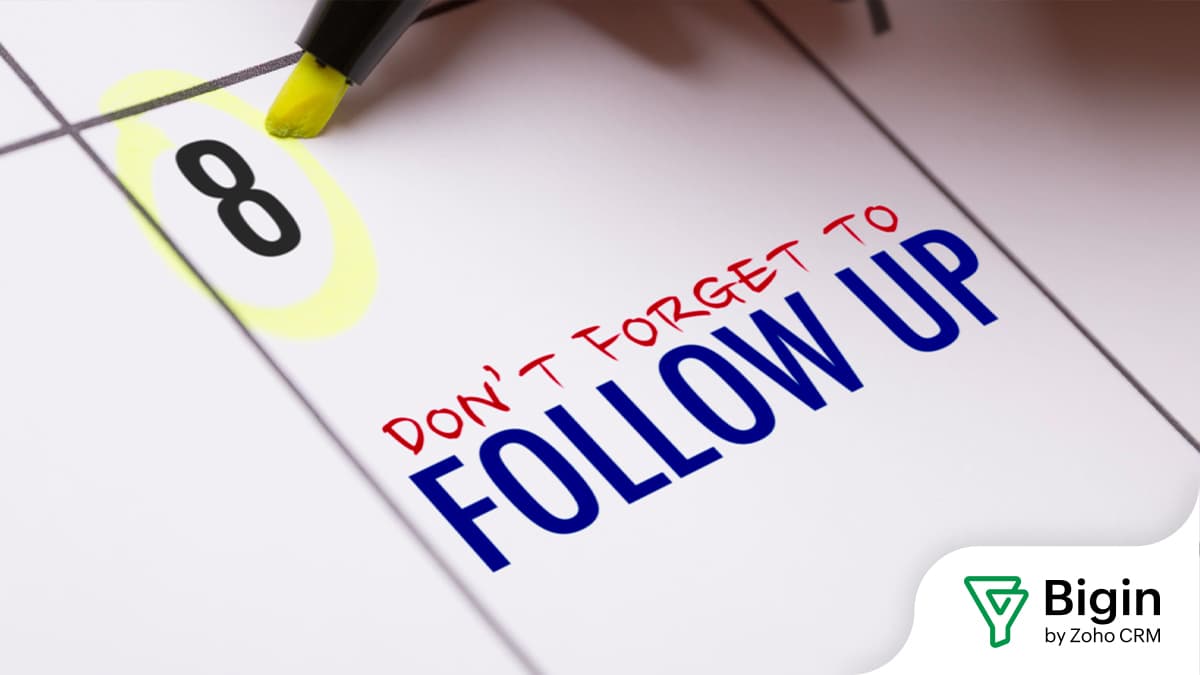The ultimate guide to effective follow-ups: Emails, calls, and LinkedIn
- Published : July 31, 2025
- Last Updated : October 3, 2025
- 355 Views
- 6 Min Read

Ever sent a sales email, a networking message, or a note to a colleague, then sat there wondering if you should follow up or just let it go?
You're not the only one. Figuring out the right time and way to follow up can be the difference between being ignored and building a real connection. Whether you're trying to move a deal forward, reconnect with someone professionally, or get a response on a work project, good follow-up habits matter.
In this guide, you'll get practical tips to help you send follow-ups that feel natural and get results. We'll cover when to reach out again, how to choose the right platform, and what to say so you don't come across as pushy or awkward. If you're ready to communicate more confidently and effectively, let's get started.
Why follow-ups matter: The real impact on your results
The power of persistence
Consistent follow-up often separates success from missing sales quotas. Studies show that most deals, responses, or opportunities don’t happen after the first message. In fact, it can take several touch points before someone replies or takes action.
Let’s put this into perspective:
Sales professionals report that 80% of deals require at least five follow-ups. [LeadGenius]
Job seekers who send a polite follow-up after an interview are far more likely to get a response.
Event organizers who check in with attendees see higher engagement and turnout.
You see, following up signals professionalism, genuine interest, and reliability. It keeps you top of mind and shows you care about the outcome.
Common fears and misconceptions
Many people hesitate to follow up because they worry about being annoying or intrusive. The truth is, most recipients appreciate a gentle nudge, especially if your message adds value or clarifies next steps.
Additionally, people are busy. Messages get buried, forgotten, or lost in the shuffle. A well-timed follow-up can actually be a relief.
Timing is everything: When to send your follow-up messages
The golden window for follow-ups
Timing your follow-up is both an art and a science. Too soon, and you might seem impatient. Too late, and the opportunity could slip away.
Here’s a practical framework:
First follow-up: Wait 2–3 business days after your initial message.
Second follow-up: If there’s still no response, wait another 4–5 business days.
Subsequent follow-ups: Space these out by a week or more, depending on urgency and context.
But wait, there’s more to consider. The best timing can vary based on the situation:
Sales inquiries: 48–72 hours is ideal for the first follow-up.
Job applications: 5–7 days after submitting your application or interview.
Internal work requests: 1–2 days, especially if deadlines are tight.
Real-world example: The sales pipeline
Imagine you’ve sent a proposal to a potential client. After three days, you follow up with a brief, friendly email checking in. If you don’t hear back, you wait another week and try a different channel, like a LinkedIn message or a quick phone call. This approach keeps the conversation alive without overwhelming the recipient.
Avoiding the “ghosting” trap
Sometimes, you won’t get a reply even after several attempts. It’s important to know when to pause or stop. A good rule of thumb: After three to four follow-ups with no response, give it a rest. You can always circle back in a few months if it’s still relevant.
Mixing your channels: Why variety boosts your response rate
The multi-channel advantage
Relying on a single channel (like email) limits your chances of getting noticed. People have different communication preferences, and their inboxes are often overflowing. By mixing channels, you increase your visibility and show adaptability.
Here are some effective channels to consider:
Email: Great for detailed information and formal communication.
Phone calls: Personal and direct, ideal for urgent matters or building rapport.
Text messages: Quick and informal, best for short reminders or confirmations.
Social media (LinkedIn, Twitter): Useful for professional networking and less formal touchpoints.
Messaging apps (Slack, WhatsApp): Perfect for internal teams or contacts who prefer instant messaging.
Example: Following up with a busy executive
Suppose you’ve emailed a proposal to a senior executive. After a few days with no reply, you send a brief LinkedIn message referencing your email. If you still don’t hear back, you might try a polite phone call or ask a mutual connection to nudge them. This channel mix increases your chances of breaking through the noise.
How to choose the right channel
Consider the recipient’s preferences, the context, and the urgency. For example:
If you know someone checks LinkedIn daily, use it for quick follow-ups.
For formal requests, stick with email.
For urgent or time-sensitive matters, a phone call or text may be best.
Additionally, always respect boundaries. If someone prefers not to be contacted on certain platforms, honor that.
Crafting effective follow-up messages: What to say and how to say it
Keep it concise and clear
Your follow-up should be brief, polite, and to the point. Avoid long-winded explanations or repeating your entire original message.
Here’s a simple structure:
Greet the recipient by name.
Reference your previous message or interaction.
State your purpose or question clearly.
Offer value, clarification, or next steps.
Close with a friendly sign-off.
Example: A winning follow-up email
Hi Sarah,
I wanted to check in regarding the proposal I sent last week. I’m happy to answer any questions or provide additional details if needed.
Looking forward to your thoughts.
Best,
Alex
Notice how this message is friendly, respectful, and easy to read. It gently reminds the recipient without sounding demanding.
Adding value in your follow-ups
Each follow-up is an opportunity to add something new. You might:
Share a relevant article or resource.
Offer a solution to a potential concern.
Provide a quick summary of key points.
Suggest a specific time for a call or meeting.
For example, if you’re following up after a sales demo, you could include a case study showing how your product helped a similar client.
Avoiding common follow-up mistakes
Overdoing it
Sending too many follow-ups in a short period can backfire. It’s important to space out your messages and respect the recipient’s time. A good rule: If you haven’t heard back after three or four attempts, pause and reassess. You can always reconnect later with a fresh angle.
Being too vague or generic
Generic messages like “Just following up” or “Checking in” don’t stand out. Be specific about what you’re referencing and what you’re hoping for.
For instance, instead of “Just checking in,” try:
"I wanted to see if you had a chance to review the project timeline I sent on Monday."
Forgetting to personalize
Personalization shows you care. Use the recipient’s name, mention previous conversations, and tailor your message to their needs or interests.
Here’s the bottom line: People respond to messages that feel genuine and relevant.
Leveraging tools and templates for smarter follow-ups
Using reminders and scheduling tools
Staying organized is half the battle. Tools like Google Calendar, Outlook, or CRM systems can help you schedule follow-ups and set reminders so nothing slips through the cracks.
Additionally, email tools like Boomerang or FollowUp.cc let you schedule messages or get notified if you haven’t received a reply.
Templates: A starting point, not a crutch
Templates can save time, but always customize them for each recipient. Here’s a basic template you can adapt:
Subject: Quick follow-up on [topic]
Hi [Name],
I wanted to follow up on my previous message regarding [topic]. Please let me know if you have any questions or if there’s a convenient time to connect.
Thanks,
[Your Name]
Remember to tweak the details and add a personal touch.
Measuring and improving your follow-up strategy
Tracking your results
How do you know if your follow-up approach is working? Track key metrics like:
Response rates by channel and timing
Number of touch points before a reply
Outcomes (meetings booked, deals closed, projects advanced)
Many CRM platforms offer built-in analytics. Even a simple spreadsheet can help you spot patterns and adjust your strategy.
Experimenting and iterating
Don’t be afraid to test different approaches. Try varying your timing, message style, or channel mix. See what gets the best results for your audience.
For example, you might find that LinkedIn messages get faster replies than emails for certain contacts. Or that sending a follow-up on Tuesday morning works better than Friday afternoon.
Here’s a tip: Keep notes on what works and refine your process over time.
Real life scenarios
Scenario 1: Networking after an event
You meet someone at a conference and exchange business cards. The next day, you send a LinkedIn connection request with a personalized note. Two days later, you follow up with a short email referencing your conversation and suggesting a coffee chat. This multi-channel approach keeps the momentum going.
Scenario 2: Project management within a team
You assign a task to a teammate via your project management tool. If there’s no update after two days, you send a quick Slack message to check in. If it’s urgent, you might call or stop by their desk. Mixing channels ensures your message gets through without overwhelming anyone.
Scenario 3: Customer support follow-up
A customer submits a support ticket. After resolving the issue, you send a follow-up email to confirm everything’s working. A week later, you follow up again with a short survey via text, asking for feedback. This shows you care about their experience and helps build loyalty.
Mastering follow-up for better results
Following up effectively means staying on someone’s radar, showing you’re engaged, and keeping the conversation moving. With the right timing and a smart mix of channels, you can get better responses and build stronger connections.
Here’s a quick recap:
Space out your follow-ups thoughtfully
Use different channels to stay visible
Keep messages short, clear, and personal
Use tools to stay organized, but don’t skip the personal touch
Track what works and adjust as you go
Now it's your turn. Take what works for you and start refining your follow-up process. A well-timed message can go a long way.
 Anubhav
AnubhavAnubhav is a product marketer with an insatiable thirst for all things content marketing, technology, and SaaS. His expertise lies in crafting compelling narratives that resonate with audiences and drive business growth. With a deep-rooted interest in entrepreneurship, Anubhav closely follows the latest industry trends and innovations, constantly seeking new ways to elevate marketing strategies.


